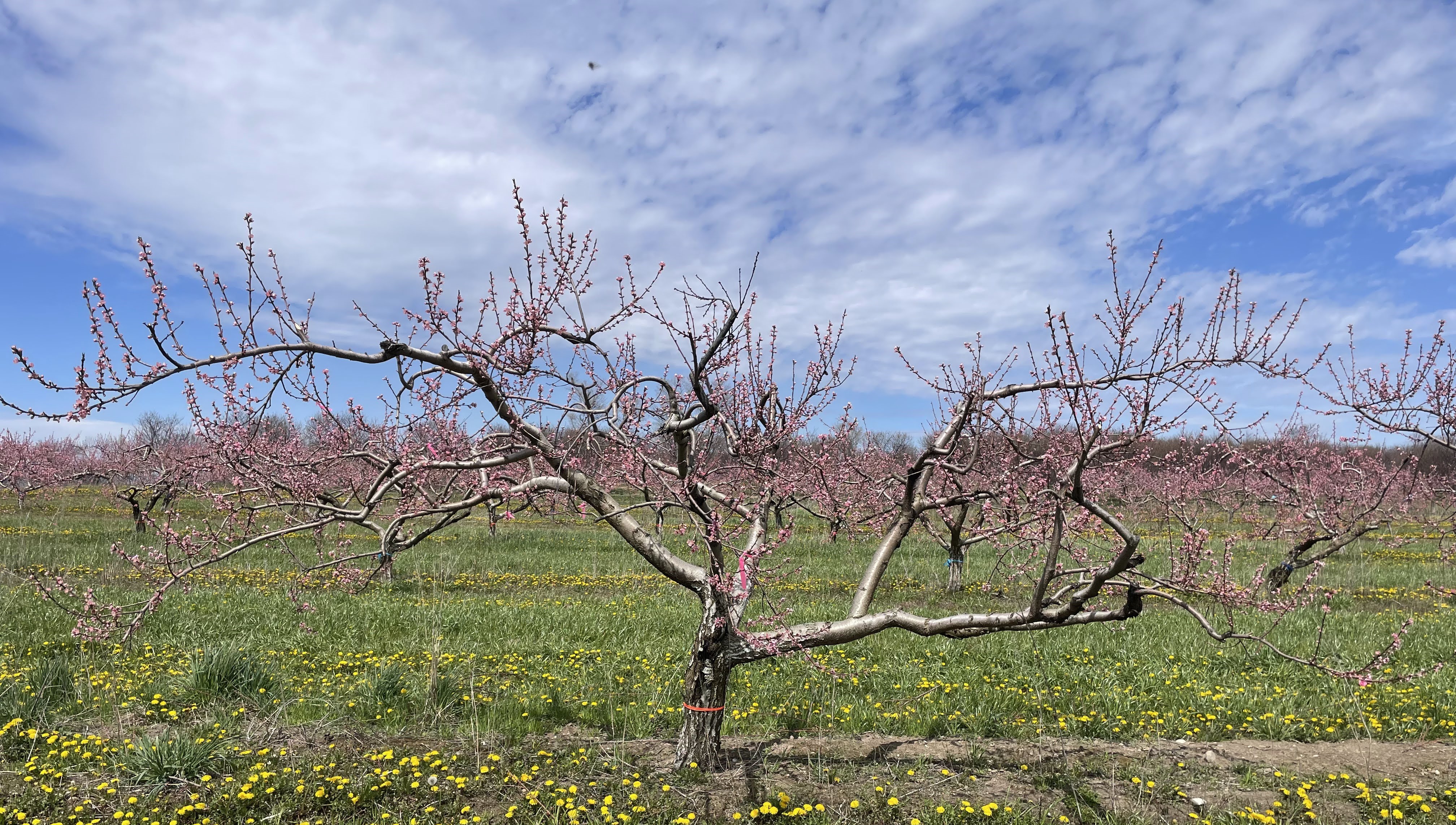West central Michigan tree fruit update – April 23, 2024
With a mix of warm and cool conditions, tree phenology has advanced slowly. Peaches are in bloom and sweet cherry bloom has begun in the region.

Temperatures have been mixed over the past week with warm and cool days and windy conditions. Last week, on warm days with highs in the 60s, bud phenology advanced rapidly (Figure 1) but then slowed over the weekend with high temperatures in the 40s and low 50s and low temperatures in the 30s. Looking ahead this week, Wednesday and Thursday, April 24 and 25, will remain cool with highs in the 40s and 50s and low temperatures in the upper 20s and low 30s in west central Michigan. A warmup is forecasted for the rest of the week and into the weekend in the region.
Based on the Hart Enviroweather station for April 22, current growing degree day (GDD) accumulation is 260.5 GDD42 and 92 GDD50. Since April 16, there has been an accumulation of 44.5 GDD at base 42 and 16 GDD at base 50.
Cool, overnight temperatures are predicted for April 24 and 25. Rain showers are forecasted for the evening of April 23 and Friday, April 26, through Monday, April 29. The mid-range forecast after this weekend is that May will be warmer and wetter than normal.
Weather data was gathered from Michigan State University Enviroweather.
Watch a full weather update from Jeff Andresen, Michigan State University climatologist.
More information and reports on normal weather conditions and departures from normal can be found on the NOAA Climate Prediction Center website, NOAA U.S. Climate Normals website, NOAA Climate Normals Quick Access Page (which may be searched by region) and Midwest Regional Climate Center website.
Crop update
Growers continue to plant trees, chop brush, prune trees and put on cover sprays this week before the rain comes over the next few days.
Bud development has slowed since last week with the cooler weather, but pollinators have been active on warm sunny days. Commercial honey bee and bumble bee hives are arriving in orchards for sweet cherry bloom and will remain for apple and tart cherry bloom over the next few weeks.
Early apple varieties in the west central region are at open cluster or first pink such as Zestar, Empire and Idared. Bud phenology has not changed very much since last week. Gala and Honeycrisp are between tight cluster and open cluster. If conditions at bloom are cool and delay fertilization, Retain (AVG) applications can be used to help extend flower viability. If slight freeze conditions occur during bloom and cause some damage to flowers, Promalin can also be applied to help preserve fruit production.
After the rain on Friday, April 19, 152 spores per rod were counted, and apple scab pressure continues to rise. Apple scab fungicide applications should be made before upcoming rain events later this week. Powdery mildew pressure was high in 2023, and treatment should begin at tight cluster, especially for blocks with high powdery mildew pressure from previous seasons and for susceptible varieties.
Early sweet cherry varieties are in early stages of bloom in Hart. Tart cherry buds are moving slowly and are at open cluster at the West Central Michigan Research and Extension Center. Brown rot management is important during bloom of sweet cherry, particularly in blocks with high disease pressure last year. Prebloom and bloom treatments are needed to manage blossom blight. Infection occurs with a wetting event with prolonged conditions of high humidity (90% or above) for 4 hours or more. The optimal temperature range for infection is 72 – 77 degrees Fahrenheit, but infection can occur between 40 and 86 F.
For tart cherry, bract leaves are beginning to expand. At that stage, leaves are susceptible to cherry leaf spot. No infection periods have been reported to date, but upcoming rain events may lead to infection periods.
Peaches are in bloom for fresh market and processing varieties. Venture peaches at the West Central Michigan Research and Extension Center are at about 50% bloom. Brown rot should also be managed for peaches during bloom before warm and rainy conditions begin this Friday.

Apricots are at petal fall. Early plums are in full bloom and early petal fall. Sprays for brown rot are warranted this week as trees are in bloom. Prune out branches with black knot and use orchard sanitization practices by burning or removing prunings.
Pear varieties, such as Bartlett, are at open cluster at the West Central Michigan Research and Extension Center. Treatment is needed to manage pear scab and protect green tissue against infection.
Pest update
Insects are becoming more active in the west central region. The insect trapline at Trevor Nichols Research Center captured green fruitworm, spotted tentiform leafminer, redbanded leafroller and oriental fruit moth this week. In Oceana County, an average of five green fruitworm per trap and three redbanded leafrollers were counted on Monday, April 22.
Oriental fruit moth was trapped at Trevor Nichols Research Center for the first time on April 15. Oriental fruit moth has not been trapped in Oceana County at this time.
For pest and disease management recommendations, please refer to the Michigan Fruit Management Guide (E-154) for product guidelines.
For more information about regional reports, please visit the Michigan State University Extension website.



 Print
Print Email
Email


